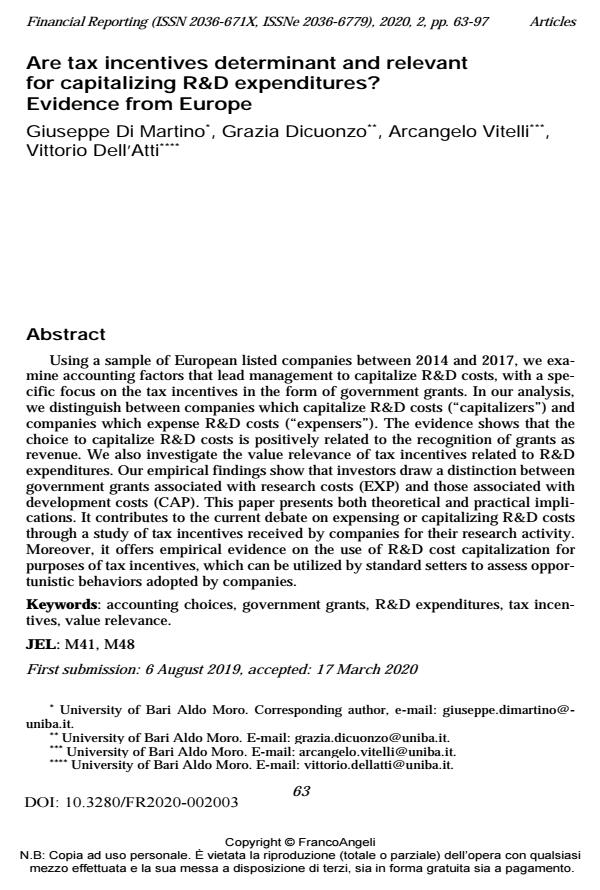Are tax incentives determinant and relevant for capitalizing R&D expenditures? Evidence from Europe
Journal title FINANCIAL REPORTING
Author/s Giuseppe Di Martino, Grazia Dicuonzo, Arcangelo Vitelli, Vittorio Dell’Atti
Publishing Year 2020 Issue 2020/2
Language English Pages 35 P. 63-97 File size 257 KB
DOI 10.3280/FR2020-002003
DOI is like a bar code for intellectual property: to have more infomation
click here
Below, you can see the article first page
If you want to buy this article in PDF format, you can do it, following the instructions to buy download credits

FrancoAngeli is member of Publishers International Linking Association, Inc (PILA), a not-for-profit association which run the CrossRef service enabling links to and from online scholarly content.
Using a sample of European listed companies between 2014 and 2017, we ex-a¬mine accounting factors that lead management to capitalize R&D costs, with a specific focus on the tax incentives in the form of government grants. In our analysis, we distinguish between companies which capitalize R&D costs ("capitalizers") and companies which expense R&D costs ("expensers"). The evidence shows that the choice to capitalize R&D costs is positively related to the recognition of grants as revenue. We also investigate the value relevance of tax incentives related to R&D expenditures. Our empirical findings show that investors draw a distinction between government grants associated with research costs (EXP) and those asso-ciated with development costs (CAP). This paper presents both theoretical and practical implications. It contributes to the current debate on expensing or capital-izing R&D costs through a study of tax incentives received by companies for their research activity. Moreover, it offers empirical evidence on the use of R&D cost capitalization for purposes of tax incentives, which can be utilized by standard set-ters to assess opportunistic behaviors adopted by companies.
Keywords: Accounting choices, government grants, R&D expenditures, tax incen-tives, value relevance.
Jel codes: M41, M48
- Effect of Corporate Taxes on Business R&D Expenditure in Central Europe Naftaly Mose, Stoyan Tanchev, Vyara Kyurova, Kamal Deen Moro, Michael Provide Fumey, in Journal of Tax Reform /2025 pp.791
DOI: 10.15826/jtr.2025.11.4.228
Giuseppe Di Martino, Grazia Dicuonzo, Arcangelo Vitelli, Vittorio Dell’Atti, Are tax incentives determinant and relevant for capitalizing R&D expenditures? Evidence from Europe in "FINANCIAL REPORTING" 2/2020, pp 63-97, DOI: 10.3280/FR2020-002003